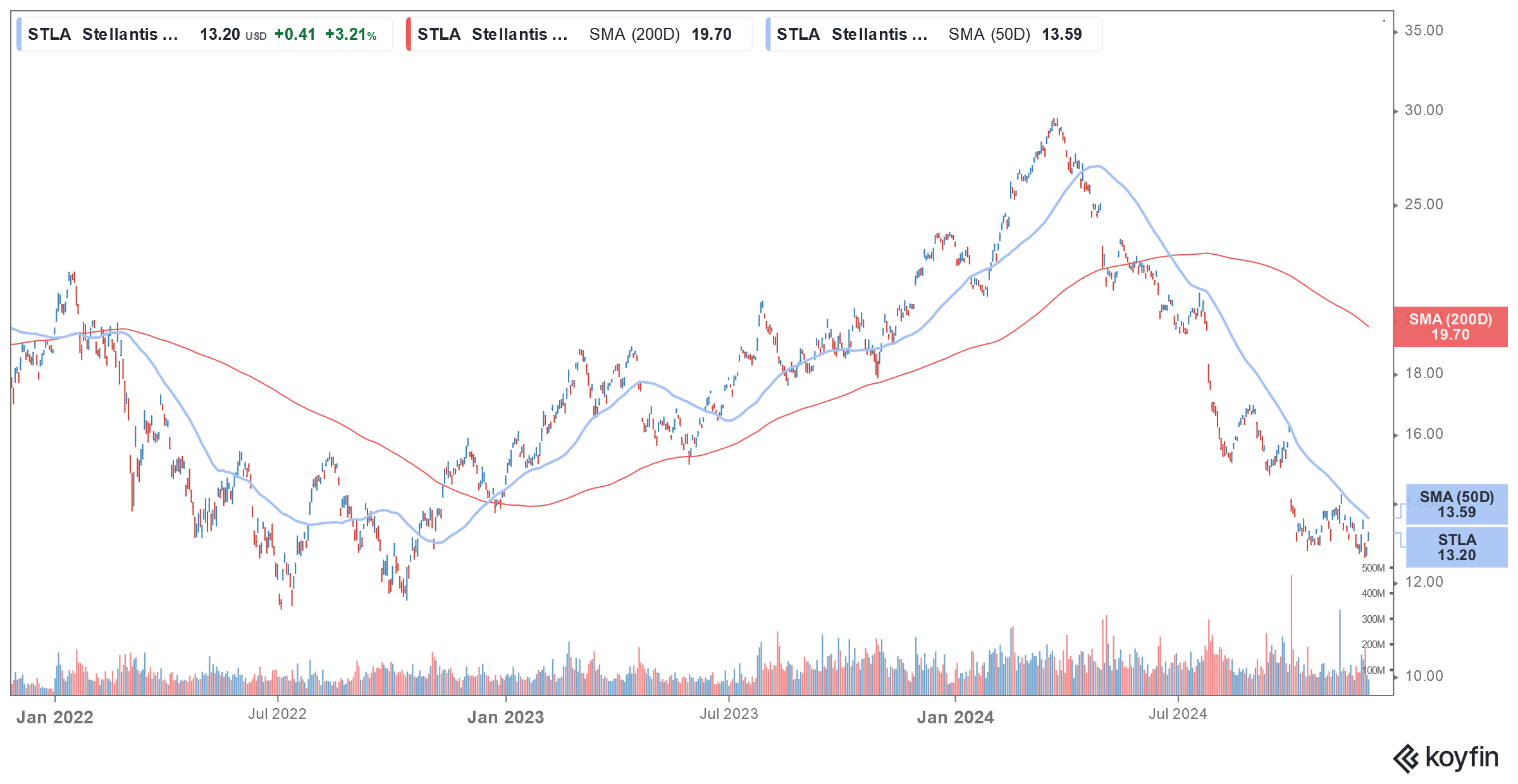Stellantis CEO Quits as the Automaker Continues to Battle Multiple Issues
Please note that we are not authorised to provide any investment advice. The content on this page is for information purposes only.
The last few years have been quite weak for legacy automakers who are battling multiple headwinds. In the most recent case, Stellantis CEO Carlos Tavares has resigned from the company amid the company’s mounting troubles while Volkswagen is separately battling a strike in Germany.
Stellantis management has accepted Tavares’ resignation and in his prepared remarks Senior Independent Director, Henri de Castries said “in recent weeks different views have emerged which have resulted in the Board and the CEO coming to today’s decision.”
The company’s release added, “The process to appoint the new permanent Chief Executive Officer is well under way, managed by a Special Committee of the Board, and will be concluded within the first half of 2025. Until then, a new Interim Executive Committee, chaired by John Elkann, will be established.”
Stellantis CEO Carlos Tavares Resigns
Tavares took over as Stellantis CEO in early 2021 when the company merged with Fiat Chrysler to create a global automotive behemoth. The company owns brands like Chrysler, Fiat, Peugeot, Ram, Jeep, Maserati, and Opel and is the fourth largest automaker globally.
The last few months have been quite troublesome for Stellantis and its sales fell 27% YoY in the third quarter. Importantly, its sales in North America – which account for the bulk of its profitability – fell 42% over the period.
The UAW, which has had a strained relationship with Stellantis welcomed Tavares’ resignation. UAW president Shawn Fain termed his departure “a major step in the right direction for a company that has been mismanaged and a workforce that has been mistreated for too long.” Fain blamed “reckless mismanagement of the company” under Tavares for Stellantis’ current woes.
He added, “Tavares is leaving behind a mess of painful layoffs and overpriced vehicles sitting on dealership lots.”
Stellantis Dealers Flagged Rising Inventories
Stellantis dealers flagged rising inventories in an open letter in September. The letter slammed Tavares for pursuing short-term profits at the cost of long-term damage to its brand.
In the letter, Stellantis National Dealer Council Kevin Farrish said, “For over two years now, the US Stellantis National Dealer Council has been sounding this alarm to your US executive team, warning them that the course you had set for Stellantis was going to be a disaster in the long run.” He added, “A disaster not just for us, but for everyone involved — and now that disaster has arrived.”
Back then, Stellantis defended its CEO, and its note said, “We meet and talk monthly, have weekly calls and personal conversations at the highest level. This is where such dialogue should take place.”
The company added, “At Stellantis, we don’t believe that public personal attacks, such as the one in the open letter from the NDC president against our CEO, are the most effective way to solve problems.”
Stellantis Cut Its 2024 Outlook
In 2024, Stellantis lowered its 2024 outlook. Notably, several other automakers including Aston Martin, Volkswagen, Nissan, and Toyota Motors also cut their 2024 outlook while Ford said that it expects its earnings to be towards the lower end of its guidance.
The automotive industry is grappling with slowing sales. Also, Western automakers are facing heightened competition in China where consumers are now pivoting to domestic brands. The US automotive market has been relatively strong but there also Stellantis has lost market share.
GM Raised Its Full-Year Guidance
General Motors has been sort of an oasis and it has raised its 2024 guidance for three consecutive quarters. During the Q3 earnings call, the Detroit giant forecast full-year adjusted pre-tax earnings of between $14 billion and $15 billion, up from the previous guidance of between $13 billion and $15 billion. GM also raised its adjusted automotive free cash flow forecast to between $12.5 billion and $13.5 billion, which is significantly higher than the previous guidance of between $9.5 billion and $11.5 billion.
GM is using its fat profits and free cash flows to repurchase shares. The company announced a $10 billion accelerated share buyback plan last year and authorized yet another $6 billion repurchase plan in June. During Q3, the company spent $1 billion on repurchases, extinguishing around 23 million shares.
Since Q3 2023 when it announced the $10 billion buyback, GM has retired 19% of its outstanding shares. The company expects to finish the current buyback program in October and would repurchase another 25 million shares taking the total share repurchased under the two plans to 250 million.
Markets have been wary of legacy automakers and they trade at single-digit PE multiples. GM too trades at dismal PE multiples despite the stellar rally over the last year.
The Automotive Industry Is Going Through Turmoil
The automotive industry in the West is going through turmoil amid weak sales of ICE (internal combustion engine) cars. Another concern for legacy automakers has been their EV (electric vehicle) business. The sales of their EVs have been quite soft while the losses are mounting. For instance, Ford expects its EV business to lose around $5 billion this year on a pre-tax basis and while GM does not specify the EV losses separately the company is also losing a lot of money in that business.
Moreover, Donald Trump’s tariff threat is a potential headwind for European automakers. As for Stellantis, apart from the industry-wide headwinds, the company is also battling company-specific issues.
Meanwhile, Stellantis stock closed sharply lower today after the CEO’s resignation and further extended its 2024 losses to nearly 50%






